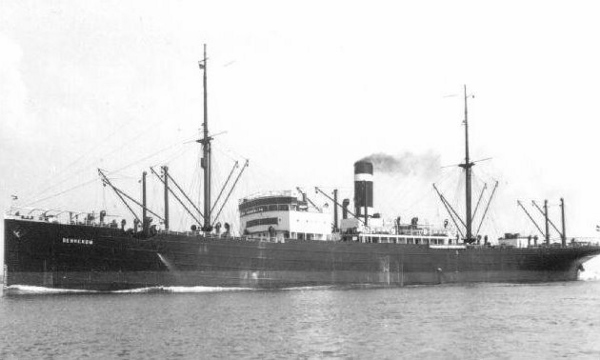Bennekom
Dutch Steam merchant

Photo courtesy of arendnet.com
| Name | Bennekom | ||
| Type: | Steam merchant | ||
| Tonnage | 5,998 tons | ||
| Completed | 1917 - Flensburger Schiffsbau-Ges., Flensburg | ||
| Owner | NV Koninklijke Nederlandsche Stoomboot Mij (KNSM), Amsterdam | ||
| Homeport | Amsterdam | ||
| Date of attack | 31 Oct 1941 | Nationality: | |
| Fate | Sunk by U-96 (Heinrich Lehmann-Willenbrock) | ||
| Position | 51° 20'N, 23° 40'W - Grid BE 1125 | ||
| Complement | 56 (9 dead and 47 survivors). | ||
| Convoy | OS-10 | ||
| Route | Liverpool (25 Oct) - Table Bay - Colombo - Madras | ||
| Cargo | 900 tons of general cargo and 300 tons of government stores | ||
| History | Launched as Gera for Deutsch-Australische DG, Hamburg, completed in February 1919 as Bürgermeister Schröder for G.J.H. Siemers & Co, Hamburg. 1920 taken over by Britain as war reparation and renamed Bourne for D.G. Pinkney & Co, Sunderland. 1921 sold to the Netherlands and renamed Bennekom for NV Koninklijke Nederlandsche Stoomboot Mij (KNSM), Amsterdam. | ||
| Notes on event | At 22.47 hours on 31 Oct 1941, U-96 fired four single torpedoes at convoy OS-10 from a long range during a full moon night and claimed the sinking of two ships with 13,000 grt. In fact, only the Bennekom (Master Leonardus Hendrik Mager) in station #22 was hit on the port side amidships in the deep tank in #4 hold by one torpedo, which had been spotted too late to be evaded by putting the wheel hard to port. The fuel oil in the tank immediately caught fire and was blown over the ship, setting the saloon and accommodation on fire. The men on the bridge were cut off from the boat deck by the flames and all means of communications were disabled as the explosion had wrecked the fore side of the bridge, including the machine gun nest there. However, the men on watch below stopped the intact engines according to orders previously arranged and the crew of 46 men, seven gunners (the ship was armed with one 4in and eight machine guns) and three passengers (British Army personnel) began to abandon ship in fine weather and calm sea. Unfortunately the deck officers were all on the forward deck after escaping from the bridge by sliding down the signal halyards, so the port aft boat and both starboard boats were launched by inexperienced engineers and stewards. The boats pulled away from the burning ship without attempting to rescue the survivors on the fore deck, as the occupants were frightened of the ship sinking and dragging the boats under. Only the port raft capable of accommodating 18 persons was available for these 25 men, because the port forward lifeboat had been destroyed and the raft on starboard drifted away just after being launched. Six men volunteered to swim, so a hatch cover was thrown overboard and they jumped after it. About 23.30 hours, the Bennekom began to sag in the middle until the shelter deck was under water and the raft was then launched with 18 men and the master hung on to the grab lines of it. After drifting for one hour they were picked up by HMS Culver (Y 87) (LtCdr R.T. Gordon-Duff, RN), while the survivors in the lifeboats were rescued by HMS Lulworth (Y 60) (LtCdr C. Gwinner, RN). The Bennekom was seen to sink by the stern about 530 miles west of Cape Clear. Six crew members and three gunners were lost. The 25 survivors aboard HMS Culver were later transferred to HMS Lulworth and all men eventually landed at Bathurst on 20 November. | ||
| On board | We have details of 56 people who were on board. | ||
If you can help us with any additional information on this vessel then please contact us.
